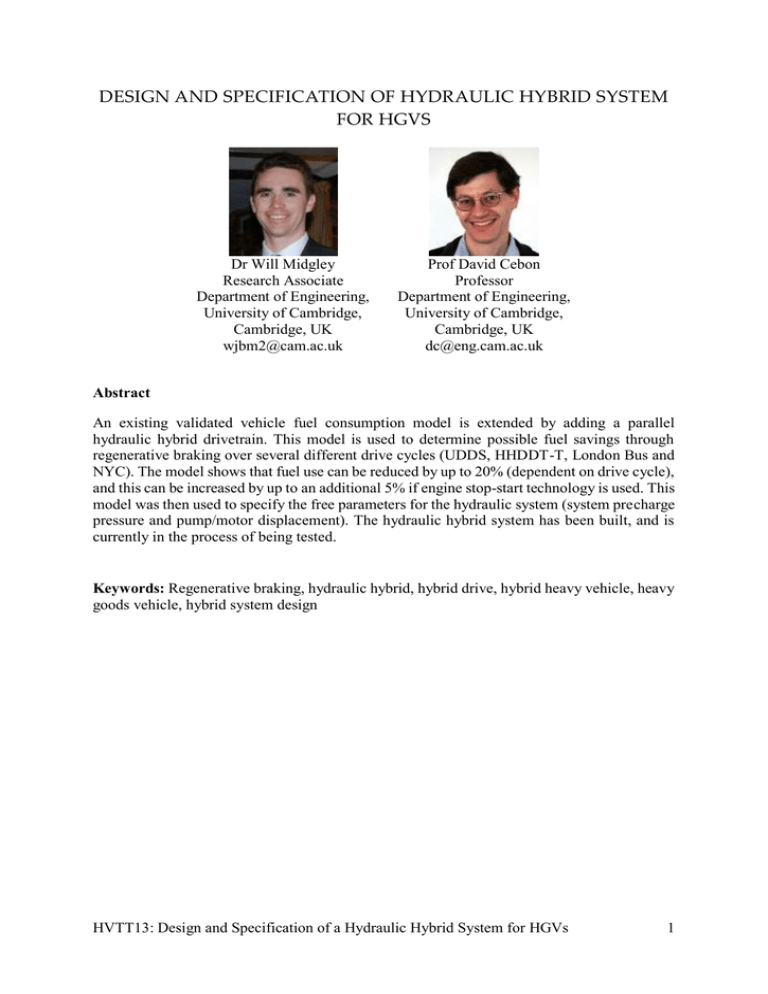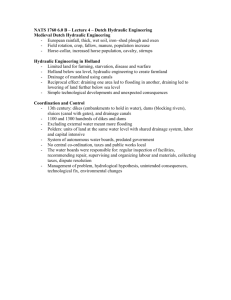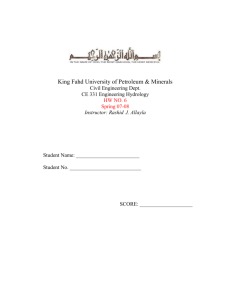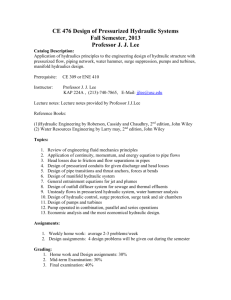DESIGN AND SPECIFICATION OF HYDRAULIC HYBRID SYSTEM FOR HGVS
advertisement

DESIGN AND SPECIFICATION OF HYDRAULIC HYBRID SYSTEM FOR HGVS Dr Will Midgley Research Associate Department of Engineering, University of Cambridge, Cambridge, UK wjbm2@cam.ac.uk Prof David Cebon Professor Department of Engineering, University of Cambridge, Cambridge, UK dc@eng.cam.ac.uk Abstract An existing validated vehicle fuel consumption model is extended by adding a parallel hydraulic hybrid drivetrain. This model is used to determine possible fuel savings through regenerative braking over several different drive cycles (UDDS, HHDDT-T, London Bus and NYC). The model shows that fuel use can be reduced by up to 20% (dependent on drive cycle), and this can be increased by up to an additional 5% if engine stop-start technology is used. This model was then used to specify the free parameters for the hydraulic system (system precharge pressure and pump/motor displacement). The hydraulic hybrid system has been built, and is currently in the process of being tested. Keywords: Regenerative braking, hydraulic hybrid, hybrid drive, hybrid heavy vehicle, heavy goods vehicle, hybrid system design HVTT13: Design and Specification of a Hydraulic Hybrid System for HGVs 1 1. Motivation In 2008 road transport was responsible for 23% of the UK’s CO2 emissions (2009a) and transport fuels accounted for 67% of the UK’s oil demand (2009d). Heavy goods vehicles (HGVs) travelled 28.7 billion kilometres, 16% of which were on urban roads (2009c). At least 3.6 million tonnes of CO2 were produced by HGVs in urban areas in 2008 (2009c, 2009b). A study conducted by Odhams et al. (Odhams, Roebuck et al., 2010) concluded that urban delivery would be up to 25% more fuel-efficient using articulated vehicles instead of rigid trucks, and up to an additional 20-30% more fuel efficient if these vehicles featured regenerative braking (when driven over a stop-start cycle). Other emissions studies have shown up to a 30% increase in fuel economy for hybrid vehicles (Vint and Gilmore, 1988, Weston, 2000, Goldman and Gorham, 2006, 2008, Holguín-Veras, 2008). Therefore, an effective way to reduce the emissions from urban delivery would be to use articulated HGVs with regenerative braking in the place of traditional (smaller) rigid vehicles. These measures would be more effective than others available (see Table 1). Such vehicles may need to incorporate steered axles on the trailer so as to have sufficient manoeuvrability through urban streets (Jujnovich and Cebon, 2013). Table 1 Comparison of fuel usage reduction measures relative to baseline tractorsemitrailer Fuel usage reduction measure Articulated vehicles Regenerative braking Stop-start hybrid Aerodynamic improvements Tyre improvements Engine efficiency improvements Approximate reduction in fuel consumption per freight task 25% 20% 7% 7% 7% 3% Reference (Odhams, Roebuck et al., 2010) (Odhams, Roebuck et al., 2010) (Baker, Cornwell et al., 2009) (Baker, Cornwell et al., 2009) (Baker, Cornwell et al., 2009) (Baker, Cornwell et al., 2009) 2. System Overview An in-depth investigation of the various alternatives for hybridisation of heavy vehicles (electric, hydraulic, flywheel) showed that hydraulic hybridisation is potentially the smallest and lightest technology (Midgley and Cebon, 2012). In order to meet the dual constraints of placing the system on a trailer, and to ensure that the axles would still be steerable, fixeddisplacement in-wheel hydraulic motors were chosen. Energy is stored in the compressed gas in high- and low-pressure (HP and LP) accumulators, and hydraulic fluid is used to transfer this energy to the in-wheel pump-motors (PMs) (see Figure 1). A valve is used to switch the PMs between pump and motor mode (see Figure 2). HVTT13: Design and Specification of a Hydraulic Hybrid System for HGVs 2 (a) (b) Figure 1 – Hydraulic regenerative braking system schematic showing system in (a) deceleration and (b) acceleration (arrows show fluid flow) Figure 2 – Hydraulic schematic of regenerative braking system 3. Simulations and Specification 3.1 Model overview A mathematical model of this system, with hydraulic PMs on each of the two trailer axles, was developed in Simulink (Midgley, Cathcart et al., 2013). This model built on an experimentally validated HGV model, developed by Hunt et al. (Hunt, Odhams et al., 2010, Odhams, Roebuck et al., 2010). An experimentally-derived efficiency map of the PMs provided by the manufacturer, and models of the hydraulic accumulators and the hydraulic fluid lines were added to the HGV model in order to give the final hydraulic hybrid model. A schematic of the model is shown in Figure 3. 3.2 Deriving the Specification Using the Model Whilst the general layout of the system had been decided, the sizes of the PMs and the hydraulic accumulators was still undetermined. The combined model outlined above was used to determine the optimal relative sizing of the PMs and accumulators along with key operating parameters such as accumulator precharge pressures and total system flowrates. The aim of the optimisation was to minimise the amount of fuel used for a given freight task. The performance measure used is the so-called ‘volumetric energy index’ (EIv) (Hunt, Odhams et al.), which gives the amount of energy required to move a cubic metre of freight one HVTT13: Design and Specification of a Hydraulic Hybrid System for HGVs 3 kilometre, as per Equation (1). Figure 3 – Simulink model schematic EI V Fuel Energy Used Payload Volume×Distance Covered (1) Due to restrictions on the pressure ranges of the accumulators (they operate best when limited to a pressure ratio from empty to full of 1:4 (Merritt, 1967)), the minimum pressure for the low-pressure accumulators (20bar, in order to ensure correct operation of the hydraulic control circuit), and the fixed-displacement nature of the PMs, the only system parameters left to specify are the HP accumulator volume and the PM displacement. The optimisation of the system was done by simulating a large number of different parameter combinations. Error! Reference source not found. shows the relationship between accumulator volume, PM size and the percentage decrease in EIv for a simple stop-start manoeuvre from 30mph (13.41m/s) at ±0.15g (1.47m/s2) The maximum percentage decrease in EIv is 26% (at point ‘C’). Composite accumulators were used for the simulation in order to minimise the weight of the system (2011). In addition, the PM manufacturer stipulated a maximum flowrate of 150l/min (0.0025m 3/s) from each wheel, which in turn gave a maximum displacement of 9.4x10 -5m3/rad at a maximum speed of 30mph (13.41m/s), the rated speed of the PMs. The PM is only made in distinct sizes, and the closest PM to this limit is the 9.97x10-5m3/rad PM. The final specification of the system is shown as point ‘A’ in Figure 4. It can be seen in Figure 4 that there is little increase in EI v reduction for PM displacements greater than 10x10 -5m3/rad, even if the flowrate constraint could be lifted. In order to minimise the fuel usage of the system during a real-world drive cycle, an engine stop-start system was also included in the model. When the vehicle is stationary, the engine is switched off. As the vehicle accelerates under hydraulic power, the engine is then switched back on. This saves the fuel that would have been burnt whilst idling. This system (with and without engine stop-start) was simulated over several legislative drive cycles (UDDS, HHDDT-T, London Bus and NYC) in order to assess its performance. The results of these simulations are shown in Figure 5. The ‘Idealised’ cycle is the simple stop-start cycle mentioned above for Figure 4. The hybrid technology is predicted to reduce the fuel usage HVTT13: Design and Specification of a Hydraulic Hybrid System for HGVs 4 by between 10% and 25% for these cycles, with the best gains coming from cycles which include many stop-start sequences (London Bus, NYC). It can also be seen that the engine stopstart technology can reduce energy usage by up to an additional 5% for cycles which include a large amount of time spent stationary, in particular the NYC cycle. Given these substantial gains in fuel efficiency, it was decided to design and build the system in order to determine the real-world performance of the hybrid system under realistic conditions. 9.97x10-5m3/rad B C A 0.83l E D Figure 4 – The reduction in EIv (%) achieved by regenerative braking over a 700m, 30mph (13.41m/s) stop-start cycle. The selected design is at point ‘A’. 25% With Stop Start EIv reduction 20% 15% 10% 5% 0% Idealised NYC UDDS London Bus HHDDT-T Figure 5 – The reduction in EIv (%) for several different drive cycles, with and without HVTT13: Design and Specification of a Hydraulic Hybrid System for HGVs 5 engine stop-start 4. System Design and Build 4.1 Vehicle Modifications The system required the re-design of several vehicle components (see Figure 6a and 6b), including combination knuckle-stub-axles and wheel hubs. It also required innovative piping to route the hydraulic fluid around the vehicle whilst allowing the necessary suspension travel and up to 25˚ steer angle on the trailer axles. This was achieved by locating manifolds with swivel joints inline with the suspension trailing arm pivot and on top of the wheel-steering king-pins. Pipe swivels Manifold inline with trailing-arm pivot Manifold PM Steering king-pin (a) Steered trailer axles (b) Figure 6 – (a) CAD image of redesigned knuckle, spindle, and knuckle manifold, with highlighted fluid paths: HP – red; LP – blue; drain – green. (b) CAD image of the final design, in situ on the CVDC experimental vehicle These custom-design and -built parts have been installed on a Cambridge Vehicle Dynamics Consortium (CVDC) trailer, and a photo of this system is included in Figure 7. Figure 8 shows the detail of the hoses connecting to the knuckle manifold. The trailer was originally built as a ‘link’ trailer for a B-double with a rear section that could be removed and used as a dolly, hence the additional 5 th wheel on the rear of the trailer. The front-most (lift) axle is used solely for moving the trailer when the dolly has been removed; it does not have steering, nor does it have the regenerative system installed on it – it is normally lifted up during testing. This arrangement is shown more clearly in Figure 9. HVTT13: Design and Specification of a Hydraulic Hybrid System for HGVs 6 High pressure accumulators Low pressure accumulators Controllers and valves Hydraulic pump/motor Flexible hydraulic hose 5th wheel Figure 7 – Assembled regenerative braking trailer Custom-built knuckle and manifold inline with steering axis Flexible hose with swivel joints at both ends Figure 8 – Close-up showing the pipe routing on the rear axle which enables ±30° of wheel steering and full suspension travel without stretching or twisting the hydraulic hoses HVTT13: Design and Specification of a Hydraulic Hybrid System for HGVs 7 ISO Container Frame joint Dolly Figure 9 – CVDC test B-link trailer before modification. Highlighted axles are steerable and were used for the experimental system 4.2 Hydraulic Circuit The detailed hydraulic circuit was designed by Poclain Hydraulics. The circuit includes a Poclain-built valve for actuating the hydraulic PMs, a pilot circuit for actuating the valve, and pressure reliefs for safety. It also includes a hydraulic fluid tank for storage of the fluid in order to make the system safe when it is being worked on. It is likely that this tank could be removed in any production system. The circuit is controlled by two electronic control units (ECUs), which communicate with a top-level controller in the cab of the vehicle, as shown schematically in Figure 10. The axle controllers immediately shut the system down if any fault is detected. The top-level controller monitors both axles, and if any fault is reported from one of the axles, or if any vehicle states are incorrect (for example vehicle speed being too high, the park brake is engaged, or the ABS is activated), then the PMs are automatically set to free-wheel with the hydraulic flows locked off. Top-level controller Axle controller 1 Axle controller 2 Axle 1 hydraulic system Axle 2 hydraulic system Figure 10 – Outline of the controller layout HVTT13: Design and Specification of a Hydraulic Hybrid System for HGVs 8 The system is currently being commissioned. It is hoped to present initial test results during the conference. 5. Conclusions a) A combined vehicle model simulating a hydraulic hybrid HGV was developed. b) This model was used to design the specification for the system, given practical constraints. c) The model gave reductions in fuel usage of up to 20%, depending on the drive cycle, with up to an additional 5% when engine stop-start was included. d) The system has been designed and built and is currently being tested. 6. Acknowledgemnets and Funding This work was supported by the New Zealand Foundation for Research, Science and Technology 1 (Grant number: CAMX0801), Poclain Hydraulics 2 , the Cambridge Vehicle Dynamics Consortium3, and the Centre for Sustainable Road Freight 4. The authors would like to thank Terry Collins and Matt Maher of Poclain Hydraulics for their support, Eric Gould, Steve Lovell and the staff of 3dEvolution for their hard work, and Team MRO for their help with this research. 7. References (2008). 2007 e-commerce Survey of Business, Office for National Statistics. (2009a). Digest of United Kingdom Energy Statistics 2009, Department for Business Enterprise and Regulatory Reform. (2009b). Guidelines to Defra / DECC’s Greenhouse Gas Conversion Factors for Company Reporting, Department for Environment Food and Rural Affairs. (2009c). Road Statistics 2008: Traffic, Speeds and Congestion, Department for Transport. (2009d). UK Energy in Brief 2009, Department for Business Enterprise and Regulatory Reform. (2011). CARBONWEIGHT High Pressure Bladder Accumulators. Colorado, Technical specification - Lightning Hybrids Inc. Baker, H., R. Cornwell, E. Koehler and J. Patterson (2009). Review of Low Carbon Technologies for Heavy Goods Vehicles - prepared for Department for Transport. Ricardo Plc. Goldman, T. and R. Gorham (2006). "Sustainable urban transport: Four innovative directions." Technology in Society 28(1-2): 261-273. Holguín-Veras, J. (2008). "Necessary conditions for off-hour deliveries and the effectiveness of urban freight road pricing and alternative financial policies in competitive markets." Transportation Research Part A: Policy and Practice 42(2): 392- 1 http://www.msi.govt.nz/ 2 http://www.poclain-hydraulics.com/en 3 http://www.cvdc.org/ 4 http://www.sustainableroadfreight.org/ HVTT13: Design and Specification of a Hydraulic Hybrid System for HGVs 9 413. Hunt, S. W., A. M. C. Odhams, R. L. Roebuck and D. Cebon (2010). "Parameter measurement for heavy-vehicle fuel consumption modelling." Proceedings of the Institution of Mechanical Engineers, Part D: Journal of Automobile Engineering 225(5): 567-589. Jujnovich, B. A. and D. Cebon (2013). "Path-Following Steering Control for Articulated Vehicles." Journal of Dynamic Systems, Measurement, and Control 135(3): 031006-031006. Merritt, H. E. (1967). Hydraulic Control Systems, John Wiley & Sons. Midgley, W., H. Cathcart and D. Cebon (2013). "Modelling of hydraulic regenerative braking systems for heavy vehicles." Proceedings of the Institution of Mechanical Engineers, Part D: Journal of Automobile Engineering 227(7): 1072-1084. Midgley, W. J. and D. Cebon (2012). "Comparison of regenerative braking technologies for heavy goods vehicles in urban environments." Proceedings of the Institution of Mechanical Engineers, Part D: Journal of Automobile Engineering 226(7): 957-970. Odhams, A. M. C., R. L. Roebuck, Y. J. Lee, S. W. Hunt and D. Cebon (2010). "Factors Influencing the Energy Consumption of Road Freight Transport." Proc IMechE Part C, J Mech Eng Sci 224(9): 1995-2010. Vint, M. K. and D. B. Gilmore (1988). "Simulation of Transit Bus Regenerative Braking Systems." Mathematics and Computers in Simulation 30(1-2): 55-61. Weston, R. (2000). The Longest Mile -- Local fulfillment services such as Webvan and Kozmo.com are competing with the Big Three deliverers for the most important piece of E-commerce real estate-the path to your door. InformationWeek, United Business Media 238-239. HVTT13: Design and Specification of a Hydraulic Hybrid System for HGVs 10








